2014 TOYOTA COROLLA run flat
[x] Cancel search: run flatPage 15 of 612

15Pictorial index
COROLLA_TMMMS_TMMC_U (OM12F00U)Windshield wipers . . . . . . . . . . . . . . . . . . . . . . . . . . . . . . . . . P. 192
Precautions against winter season . . . . . . . . . . . . . . . . . . . . . P. 216
Fuel filler door . . . . . . . . . . . . . . . . . . . . . . . . . . . . . . . . . . . . P. 194
Refueling method . . . . . . . . . . . . . . . . . . . . . . . . . . . . . . . . . . . P. 194
Fuel type/fuel tank capacity . . . . . . . . . . . . . . . . . . . . . . . . . . . P. 546
Tires . . . . . . . . . . . . . . . . . . . . . . . . . . . . . . . . . . . . . . . . . . P. 448
Tire size/inflation pressure . . . . . . . . . . . . . . . . . . . . . . . . . P. 552
Winter tires/tire chain . . . . . . . . . . . . . . . . . . . . . . . . . . . . . P. 216
Checking/rotation/tire pressure warning system
*1 . . . . . . . P. 448
Coping with flat tires . . . . . . . . . . . . . . . . . . . . . . . . . . . . . . P. 514
Hood . . . . . . . . . . . . . . . . . . . . . . . . . . . . . . . . . . . . . . . . . . . . P. 431
Opening . . . . . . . . . . . . . . . . . . . . . . . . . . . . . . . . . . . . . . . . . . P. 431
Engine oil . . . . . . . . . . . . . . . . . . . . . . . . . . . . . . . . . . . . . . . . . P. 546
Coping with overheat . . . . . . . . . . . . . . . . . . . . . . . . . . . . . . . . P. 537
Headlights/daytime running lights . . . . . . . . . . . . . . . . . . . . P. 184
Front turn signal/parking lights . . . . . . . . . . . . . . . . . . . . . . P. 184
Front fog lights
*1. . . . . . . . . . . . . . . . . . . . . . . . . . . . . . . . . . P. 191
Front side marker lights . . . . . . . . . . . . . . . . . . . . . . . . . . . . P. 184
Turn signal lights
*1 . . . . . . . . . . . . . . . . . . . . . . . . . . . . . . . . P. 182
Stop/tail lights/rear side marker lights . . . . . . . . . . . . . . . . . P. 184
Back-up lights
Shifting the shift lever to R . . . . . . . . . . . . . . . . P. 172, 174, 176, 180
License plate lights . . . . . . . . . . . . . . . . . . . . . . . . . . . . . . . . P. 184
4
5
6
7
Light bulbs of the exterior lights for driving
(Replacing method: P. 470, Watts: P. 553)
*1: If equipped
*2: Vehicles with a drive monitor display
*3: Vehicles with a multi-information display
8
9
10
11
12
13
14
15
Page 209 of 612

2094-5. Using the driving support systems
4
Driving
COROLLA_TMMMS_TMMC_U (OM12F00U)
CAUTION
■When using the rear view monitor system
The rear view monitor system is a supplemental device intended to assist
the driver when backing up. When backing up, be sure to check visually
behind and all around the vehicle before proceeding.
Observe the following precautions to avoid an accident that could result in
death or serious injuries.
●Never depend on the rear view monitor system entirely when backing up.
The image and the position of the guide lines displayed on the screen may
differ from the actual state.
Use caution, just as you would when backing up any vehicle.
●Be sure to back up slowly, depressing the brake pedal to control vehicle
speed.
●The instructions given are only guidelines.
When and how much to turn the steering wheel will vary according to traf-
fic conditions, road surface conditions, vehicle condition, etc. when park-
ing. It is necessary to be fully aware of this before using the rear view
monitor system.
●When parking, be sure to check that the parking space will accommodate
your vehicle before maneuvering into it.
●Do not use the rear view monitor system in the following cases:
• On icy or slick road surfaces, or in snow
• When using tire chains or the compact spare tire
• When the trunk lid is not closed completely
• On roads that are not flat or straight, such as curves or slopes.
●In low temperatures, the screen may darken or the image may become
faint. The image could distort when the vehicle is moving, or you may
become unable to see the image on the screen. Be sure to check direct
visually and with the mirrors all around the vehicle before proceeding.
●If the tire sizes are changed, the position of the fixed guide lines displayed
on the screen may change.
●The camera uses a special lens. The distances between objects and
pedestrians that appear in the image displayed on the screen will differ
from the actual distances. (P. 204)
Page 426 of 612

4267-2. Maintenance
COROLLA_TMMMS_TMMC_U (OM12F00U)
Vehicle exterior
ItemsCheck points
Doors/trunk• Do the doors/trunk operate
smoothly?
Engine hood• Does the engine hood lock system
work properly?
Fluid leaks
• There should not be any signs of
fluid leakage after the vehicle has
been parked.
Tires
• Is the tire inflation pressure cor-
rect?
• The tires should not be dam-
aged or excessively worn.
• Have the tires been rotated
according to the maintenance
schedule?
• The wheel nuts should not be
loose.
Windshield wipers
• The wiper blades should not show
any signs of cracking, splitting,
wear, contamination or deforma-
tion.
• The wiper blades should clear the
windshield without streaking or
skipping.
CAUTION
■If the engine is running
Turn the engine off and ensure that there is adequate ventilation before per-
forming maintenance checks.
Page 485 of 612
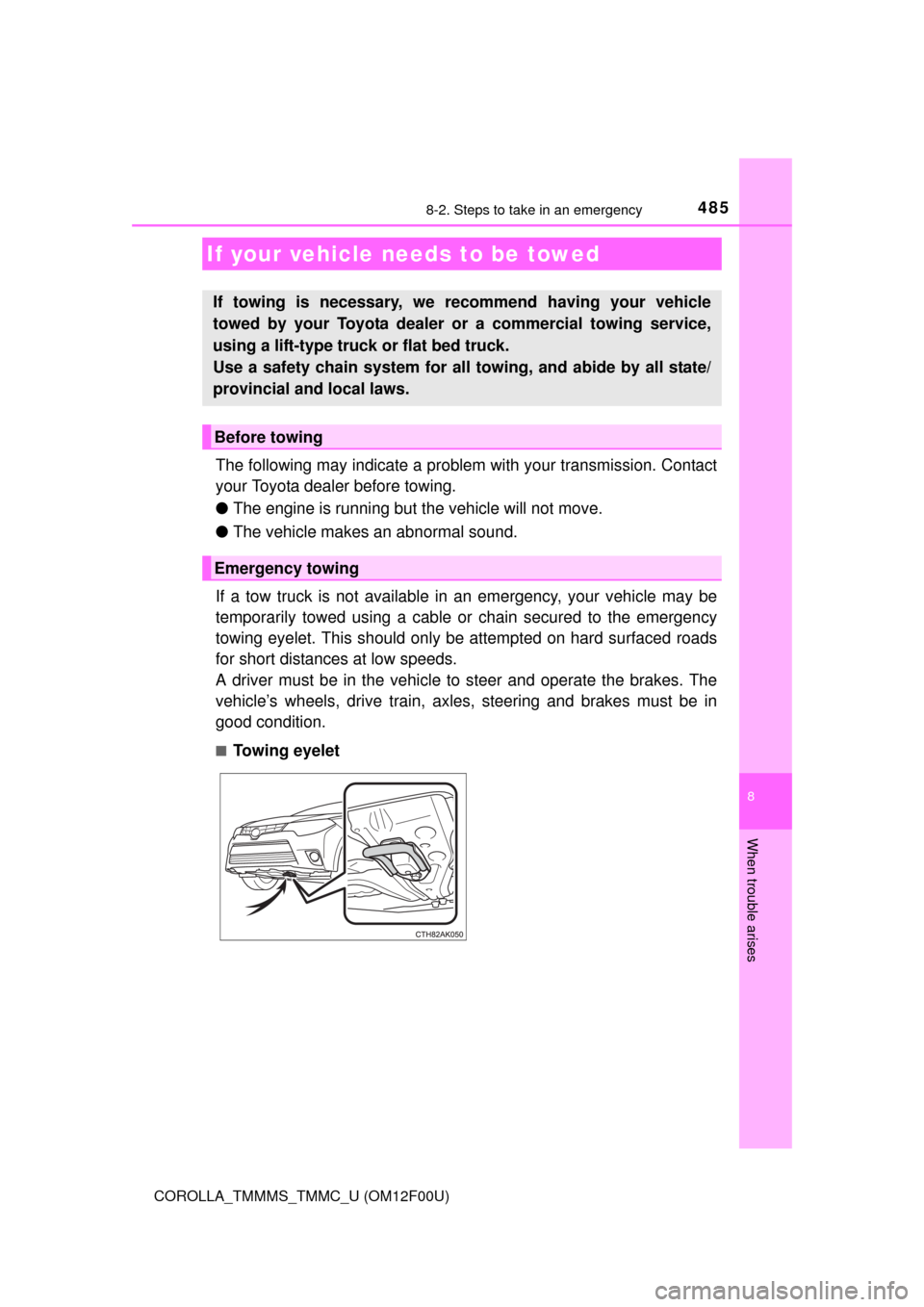
485
8
When trouble arises
COROLLA_TMMMS_TMMC_U (OM12F00U)
8-2. Steps to take in an emergency
The following may indicate a problem with your transmission. Contact
your Toyota dealer before towing.
●The engine is running but the vehicle will not move.
●The vehicle makes an abnormal sound.
If a tow truck is not available in an emergency, your vehicle may be
temporarily towed using a cable or chain secured to the emergency
towing eyelet. This should only be attempted on hard surfaced roads
for short distances at low speeds.
A driver must be in the vehicle to steer and operate the brakes. The
vehicle’s wheels, drive train, axles, steering and brakes must be in
good condition.
If your vehicle needs to be towed
If towing is necessary, we recommend having your vehicle
towed by your Toyota dealer or a commercial towing service,
using a lift-type truck or flat bed truck.
Use a safety chain system for all towing, and abide by all state/
provincial and local laws.
Before towing
Emergency towing
■Towing eyelet
Page 488 of 612
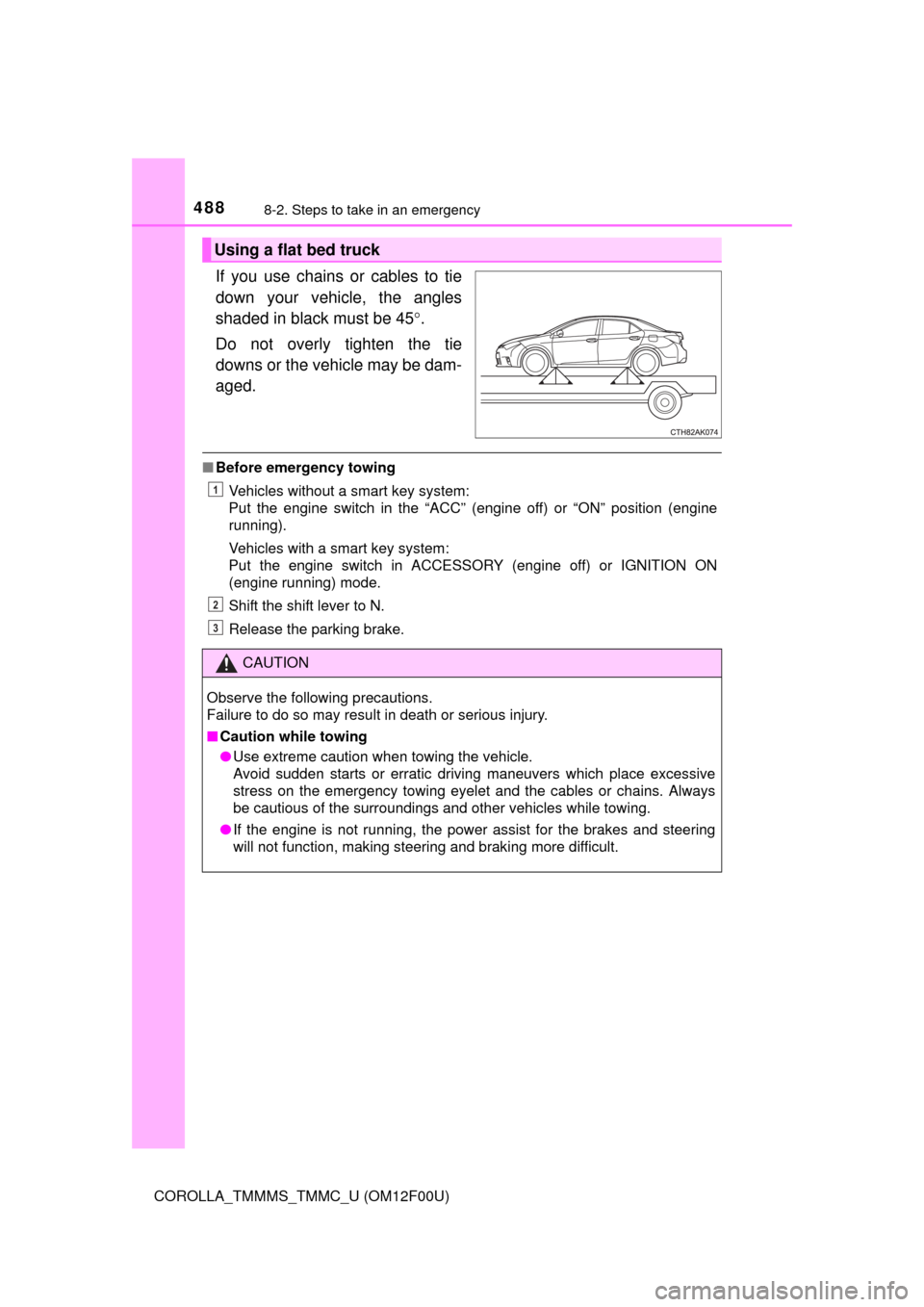
4888-2. Steps to take in an emergency
COROLLA_TMMMS_TMMC_U (OM12F00U)
If you use chains or cables to tie
down your vehicle, the angles
shaded in black must be 45.
Do not overly tighten the tie
downs or the vehicle may be dam-
aged.
■Before emergency towing
Vehicles without a smart key system:
Put the engine switch in the “ACC” (engine off) or “ON” position (engine
running).
Vehicles with a smart key system:
Put the engine switch in ACCESSORY (engine off) or IGNITION ON
(engine running) mode.
Shift the shift lever to N.
Release the parking brake.
Using a flat bed truck
CAUTION
Observe the following precautions.
Failure to do so may result in death or serious injury.
■Caution while towing
●Use extreme caution when towing the vehicle.
Avoid sudden starts or erratic driving maneuvers which place excessive
stress on the emergency towing eyelet and the cables or chains. Always
be cautious of the surroundings and other vehicles while towing.
●If the engine is not running, the power assist for the brakes and steering
will not function, making steering and braking more difficult.
1
2
3
Page 490 of 612
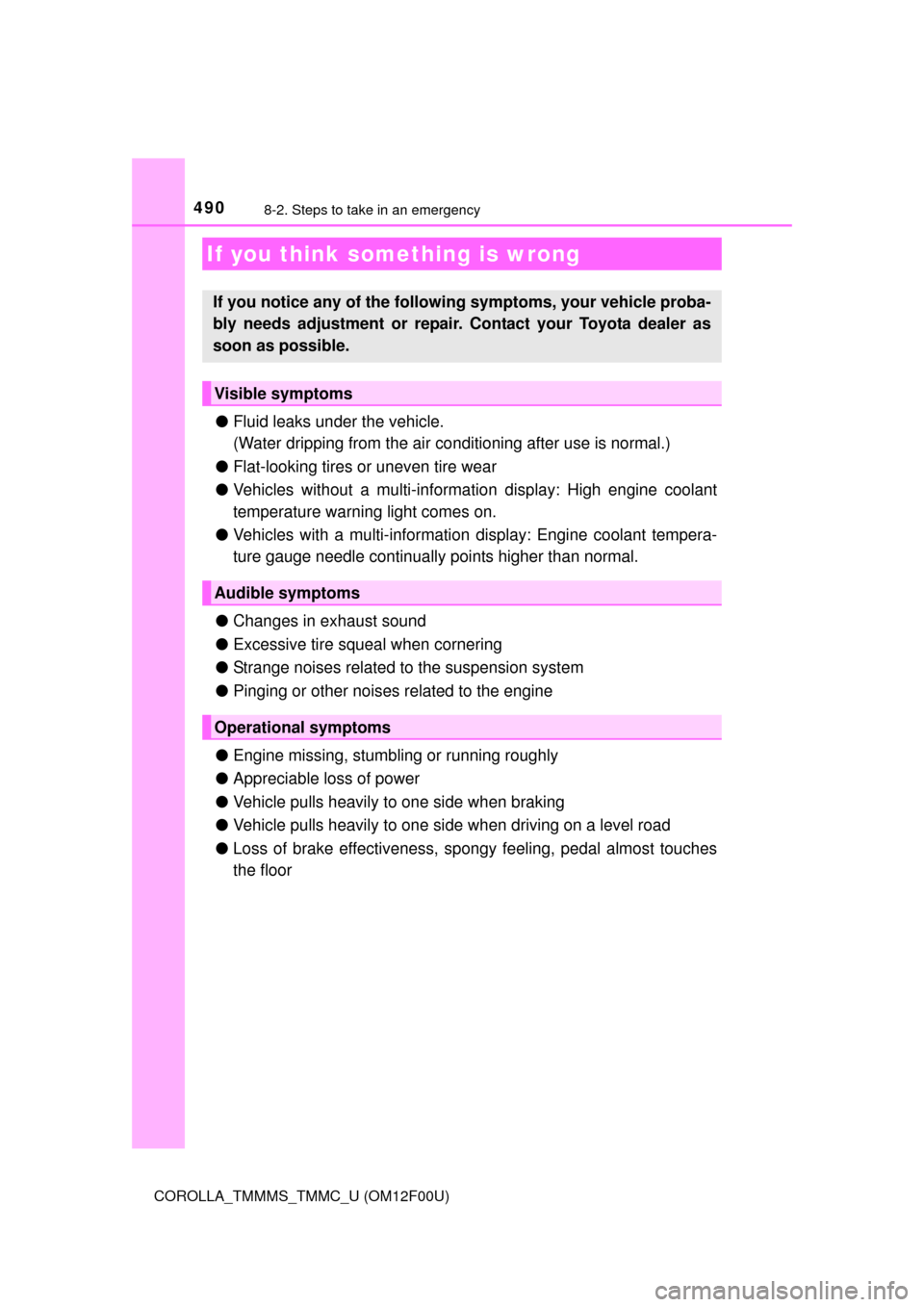
4908-2. Steps to take in an emergency
COROLLA_TMMMS_TMMC_U (OM12F00U)
●Fluid leaks under the vehicle.
(Water dripping from the air conditioning after use is normal.)
●Flat-looking tires or uneven tire wear
●Vehicles without a multi-information display: High engine coolant
temperature warning light comes on.
●Vehicles with a multi-information display: Engine coolant tempera-
ture gauge needle continually points higher than normal.
●Changes in exhaust sound
●Excessive tire squeal when cornering
●Strange noises related to the suspension system
●Pinging or other noises related to the engine
●Engine missing, stumbling or running roughly
●Appreciable loss of power
●Vehicle pulls heavily to one side when braking
●Vehicle pulls heavily to one side when driving on a level road
●Loss of brake effectiveness, spongy feeling, pedal almost touches
the floor
If you think something is wrong
If you notice any of the following symptoms, your vehicle proba-
bly needs adjustment or repair. Contact your Toyota dealer as
soon as possible.
Visible symptoms
Audible symptoms
Operational symptoms
Page 494 of 612
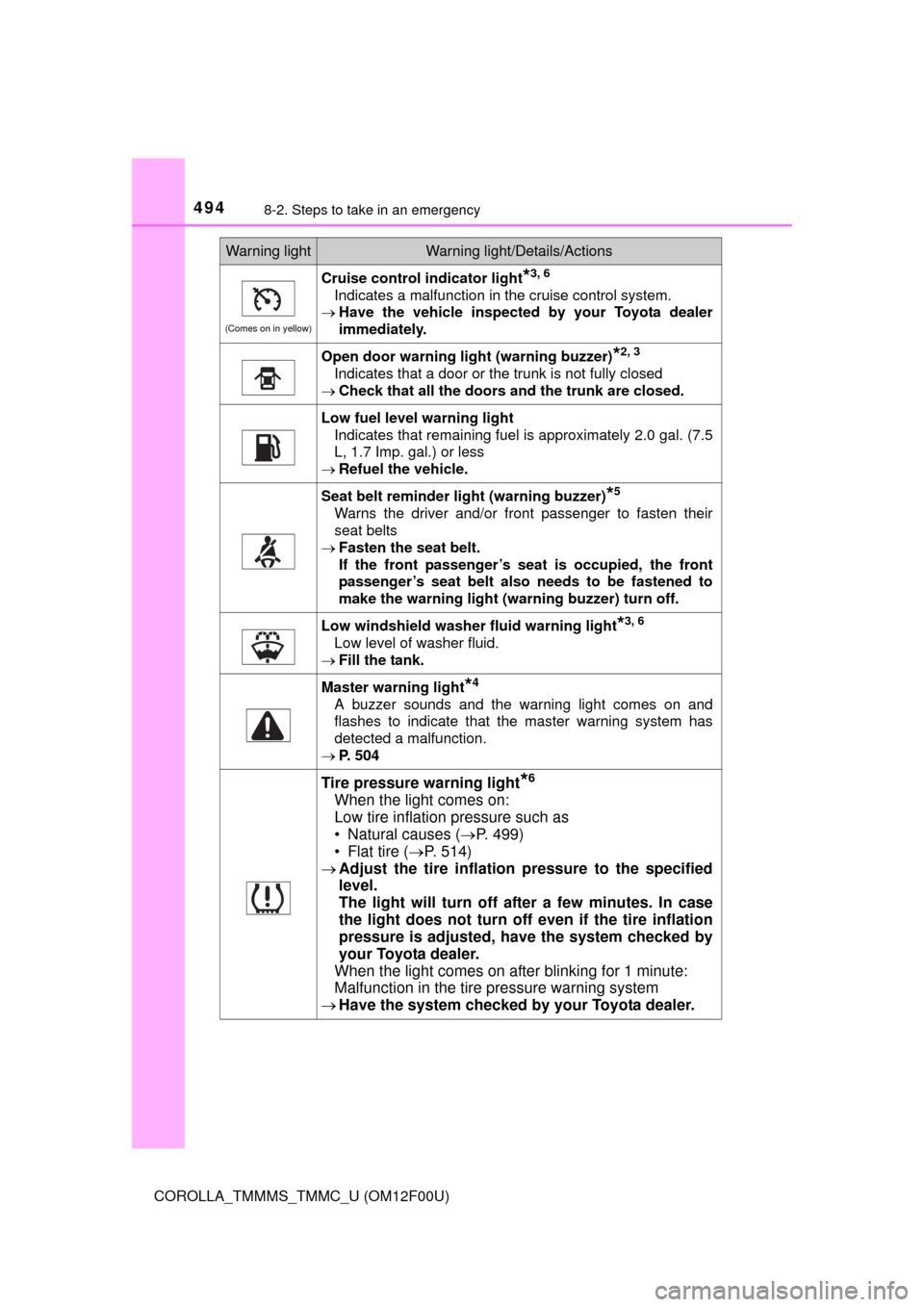
4948-2. Steps to take in an emergency
COROLLA_TMMMS_TMMC_U (OM12F00U)
(Comes on in yellow)
Cruise control indicator light*3, 6
Indicates a malfunction in the cruise control system.
Have the vehicle inspected by your Toyota dealer
immediately.
Open door warning light (warning buzzer)*2, 3
Indicates that a door or the trunk is not fully closed
Check that all the doors and the trunk are closed.
Low fuel level warning light
Indicates that remaining fuel is approximately 2.0 gal. (7.5
L, 1.7 Imp. gal.) or less
Refuel the vehicle.
Seat belt reminder light (warning buzzer)*5
Warns the driver and/or front passenger to fasten their
seat belts
Fasten the seat belt.
If the front passenger’s seat is occupied, the front
passenger’s seat belt also needs to be fastened to
make the warning light (warning buzzer) turn off.
Low windshield washer fluid warning light*3, 6
Low level of washer fluid.
Fill the tank.
Master warning light*4
A buzzer sounds and the warning light comes on and
flashes to indicate that the master warning system has
detected a malfunction.
P. 504
Tire pressure warning light*6
When the light comes on:
Low tire inflation pressure such as
• Natural causes (P. 499)
• Flat tire (P. 514)
Adjust the tire inflation pressure to the specified
level.
The light will turn off after a few minutes. In case
the light does not turn off even if the tire inflation
pressure is adjusted, have the system checked by
your Toyota dealer.
When the light comes on after blinking for 1 minute:
Malfunction in the tire pressure warning system
Have the system checked by your Toyota dealer.
Warning lightWarning light/Details/Actions
Page 568 of 612
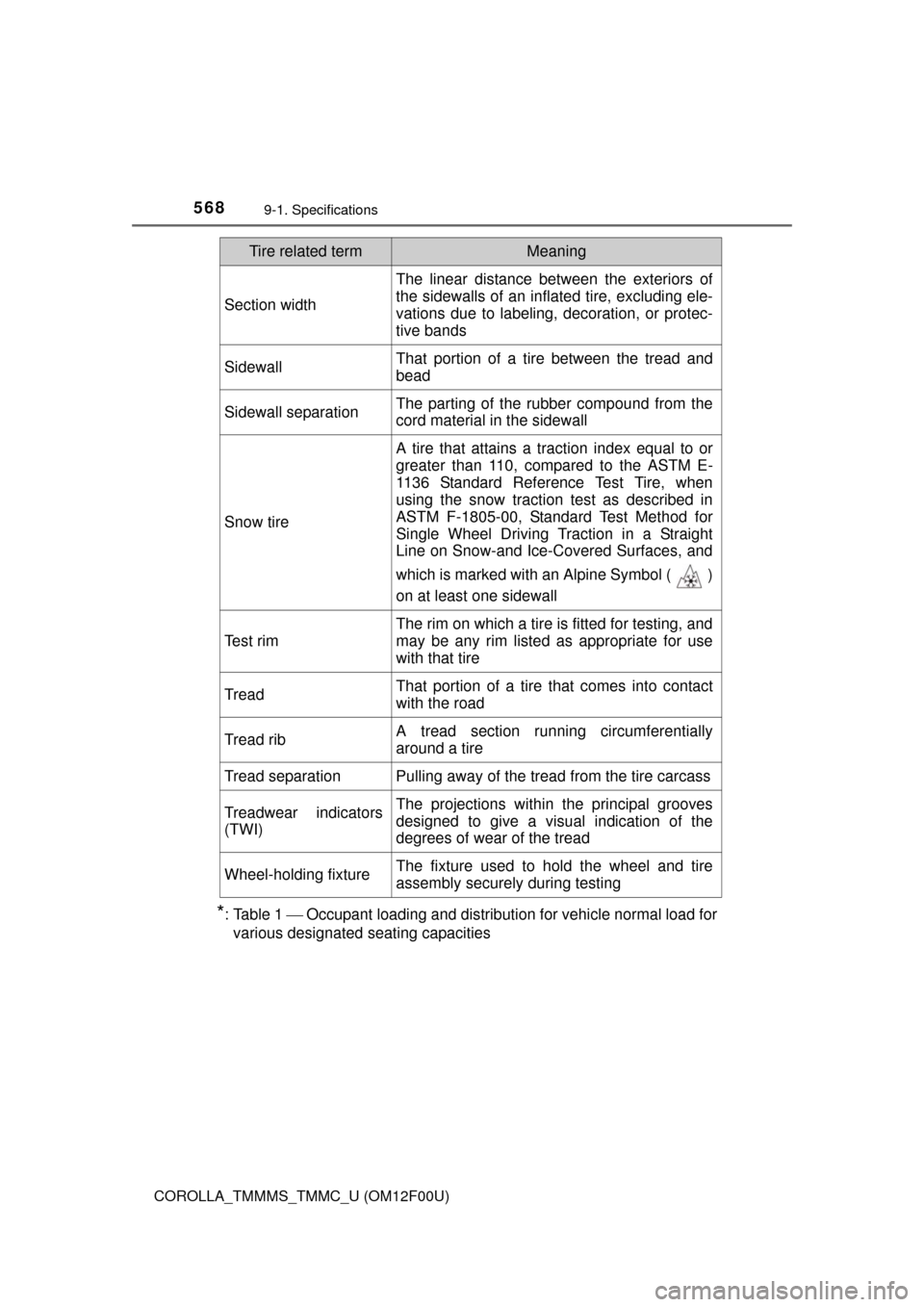
5689-1. Specifications
COROLLA_TMMMS_TMMC_U (OM12F00U)
*: Table 1 Occupant loading and distribution for vehicle normal load for
various designated seating capacities
Section width
The linear distance between the exteriors of
the sidewalls of an inflated tire, excluding ele-
vations due to labeling, decoration, or protec-
tive bands
SidewallThat portion of a tire between the tread and
bead
Sidewall separationThe parting of the rubber compound from the
cord material in the sidewall
Snow tire
A tire that attains a traction index equal to or
greater than 110, compared to the ASTM E-
1136 Standard Reference Test Tire, when
using the snow traction test as described in
ASTM F-1805-00, Standard Test Method for
Single Wheel Driving Traction in a Straight
Line on Snow-and Ice-Covered Surfaces, and
which is marked with an Alpine Symbol ( )
on at least one sidewall
Test rim
The rim on which a tire is fitted for testing, and
may be any rim listed as appropriate for use
with that tire
TreadThat portion of a tire that comes into contact
with the road
Tread ribA tread section running circumferentially
around a tire
Tread separationPulling away of the tread from the tire carcass
Treadwear indicators
(TWI)The projections within the principal grooves
designed to give a visual indication of the
degrees of wear of the tread
Wheel-holding fixtureThe fixture used to hold the wheel and tire
assembly securely during testing
Tire related termMeaning